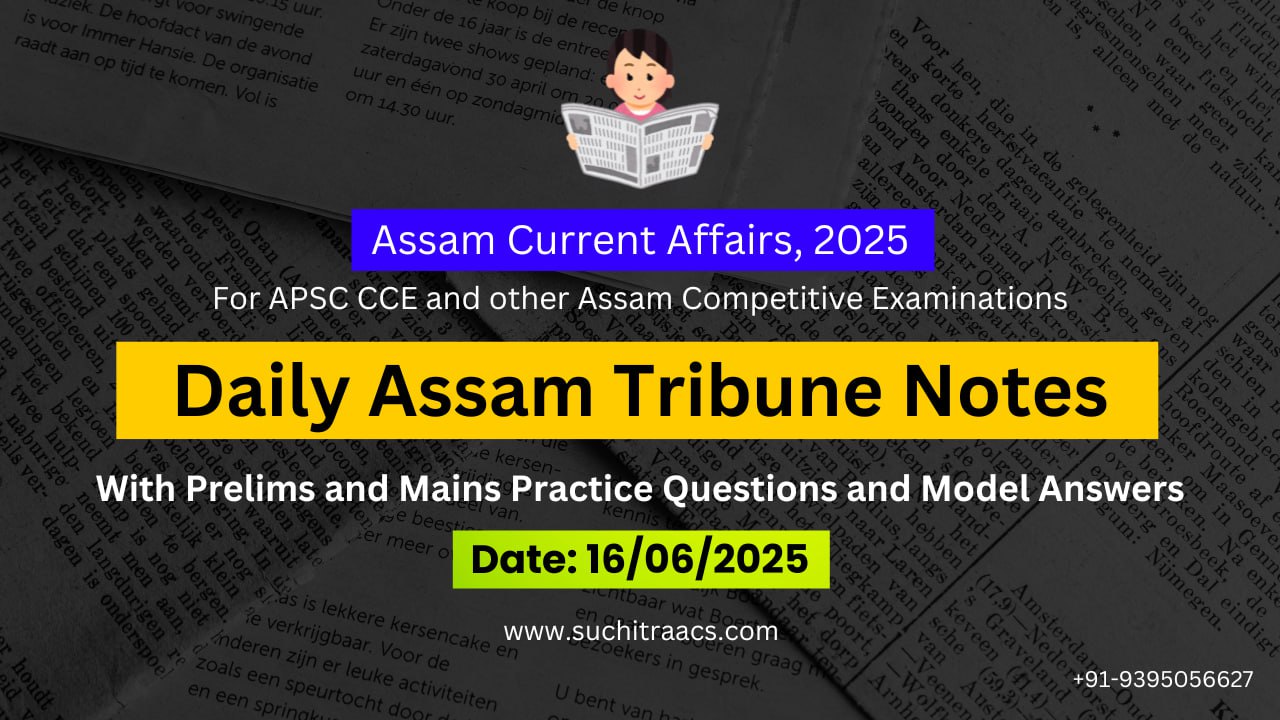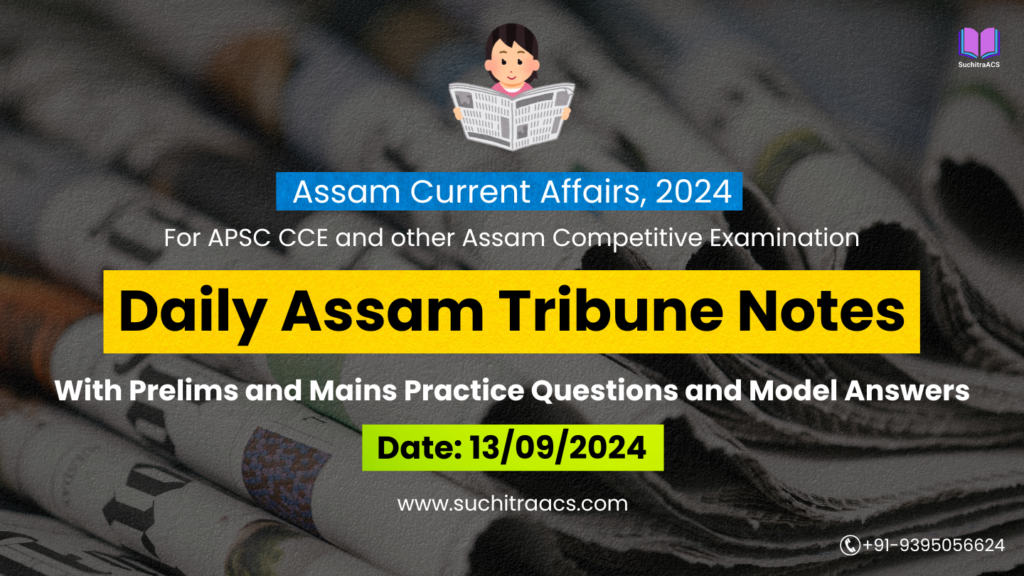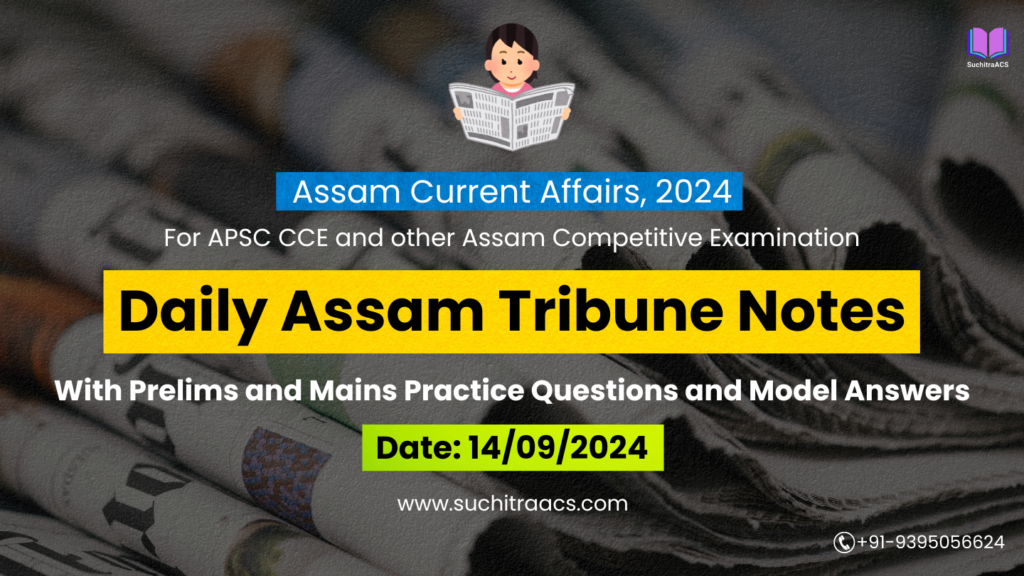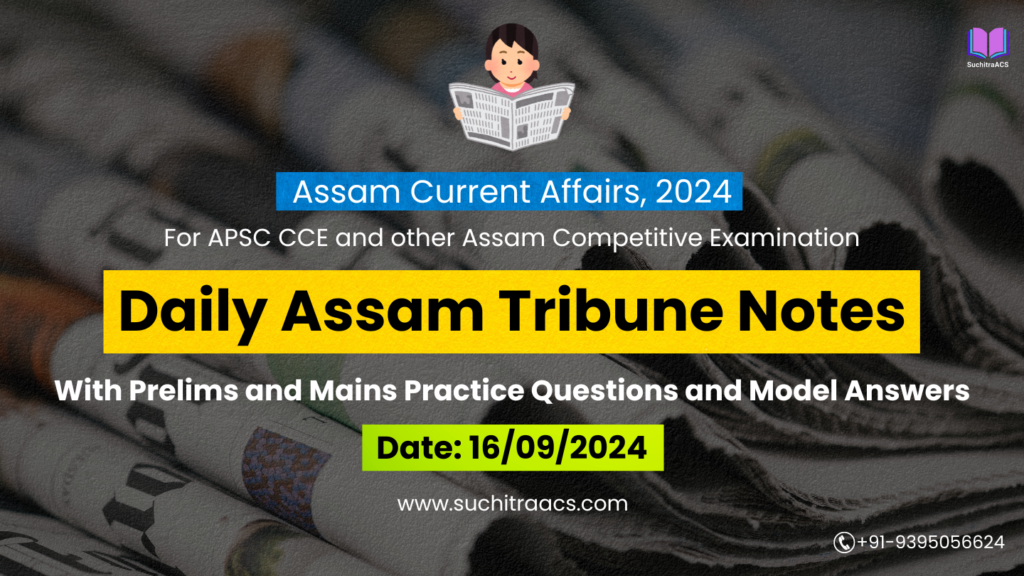APSC Current Affairs: Assam Tribune Notes with MCQs and Answer Writing (16/06/2025)
For APSC CCE and other Assam Competitive examinations aspirants, staying updated with current affairs is vital. This blog covers most important topics from the Assam Tribune today (16-06-2025). These issues are key for both APSC Prelims and Mains preparation, offering insights into the APSC CCE Syllabus.
✨ APSC CCE Online Coaching, 2026

🛑 Ninth Addition to Kaziranga National Park Cancelled: Conservation Setback or Policy Shift?
📘 GS Paper 3: Environment & Ecology | Protected Areas | Biodiversity Conservation
📘 GS Paper 5 (APSC): Assam – Wildlife, Forest Governance, Eco-sensitive Zones
🔹 Introduction
The Government of Assam has officially withdrawn the preliminary notification (issued in 2020) for the 9th addition (2,570 hectares) to the Kaziranga National Park and Tiger Reserve, a UNESCO World Heritage Site. This move has ignited sharp criticism from conservationists who view it as a rollback of ecological commitments. It follows the recent withdrawal of an integrated Eco-Sensitive Zone (ESZ) proposal that aimed to protect over 3,600 sq km across the Kaziranga landscape.
🔑 Key Details
| Parameter | Description |
| Area Involved | 2,570 hectares (9th addition), in Tezpur Revenue Circle, Sonitpur District |
| Date of Original Notification | September 2020 |
| Denotified By | Assam Government under Section 35 of the Wildlife Protection Act, 1972 |
| Importance of Land | Used by rhinos, elephants, tigers, migratory birds, wild pigs, turtles |
| Connectivity Role | Corridor between Kaziranga and Nameri National Park |
| Justification for Withdrawal | Development pressure, ESZ-related community & infrastructure challenges |
🧠 Prelims Pointers
Section 35, Wildlife Protection Act (1972): Empowers government to declare and alter boundaries of national parks
Kaziranga: UNESCO World Heritage Site; home to ~2,600 one-horned rhinos
Eco-Sensitive Zone (ESZ): Buffer around protected areas for low-impact development
Corridor Ecology: Wildlife corridors allow safe species migration and gene flow
Nameri National Park: Part of the transboundary corridor with Arunachal’s Pakke Tiger Reserve
📝 Mains Pointers
A. Ecological Significance of the 9th Addition Area
Habitat for mega-herbivores like Asiatic wild buffalo, elephants, rhinos
Part of seasonal migration route for tigers, elephants between Kaziranga and Nameri
Includes islands of Jia Bharali River, critical for nesting birds and turtles
Helps mitigate human-wildlife conflict through spatial buffer
B. Arguments for Denotification (Govt Justification)
| Issue | Description |
| Infrastructure Conflict | Presence of roads, buildings, and settlements in proposed addition area |
| ESZ Overreach Concerns | 3,600 sq km integrated ESZ faced opposition from communities, local bodies |
| Governance Capacity | Staff and budget deficits to manage expanded protected zones |
| Displacement Fear | Fears among local populations of livelihood restrictions and relocation |
C. Conservationist Concerns
Signals regression in wildlife commitment
Undermines the Kaziranga–Nameri corridor, vital for long-term species survival
Sets precedent for de-gazettement of protected areas under development pressure
Reflects short-sighted prioritisation of industry over biodiversity
D. Wider Conservation Context in Assam
| Contextual Policy | Remarks |
| Assam Forest Department | Faces over 50% staff shortage in key reserves like Manas, Orang |
| Recent Additions | 10th Addition (2021) may also be at risk – despite having no human habitation |
| Manas & Nameri Challenges | Similar issues of encroachment, poor staffing, and budgetary cuts |
📑 Reports & Frameworks
Eco-Sensitive Zone Guidelines – MoEFCC (2011)
Wildlife Action Plan (2017–2031): Focus on landscape-level conservation
Project Elephant & Project Tiger: Flagship schemes endangered by corridor loss
UNESCO World Heritage Guidelines: Emphasise sustainable park expansion
🧭 Way Forward
| Recommendation | Strategy |
| Corridor Mapping | Scientific mapping of seasonal corridors with buffer provisions |
| Community Integration | Incentivise community conservation via eco-development committees (EDCs) |
| Funding Support | Tap into CAMPA, CSR, and World Bank-assisted biodiversity grants |
| Balanced ESZ Zoning | Categorise zones into core, transition, and sustainable use belts |
| Judicial Oversight | High Court/SC monitoring of PA boundary alterations for transparency |
🧩 Conclusion
The withdrawal of Kaziranga’s 9th addition marks a critical inflection point in Assam’s conservation journey. While development needs are genuine, the move risks compromising long-term ecological stability, especially when Assam is a global hotspot for endangered fauna. What’s required is a balanced, science-backed policy framework that protects biodiversity while respecting local aspirations.
🚫 Assam Government Bans Popular Front of India (PFI)-Linked NGOs: National Security and Civil Society Dynamics
📘 GS Paper 3: Internal Security | NGOs & Extremism | Terrorism Financing
📘 GS Paper 2: Governance | Role of Civil Society | Regulatory Framework
📘 GS Paper 5 (APSC): Assam – Counter-Extremism Measures | NGO Oversight | Community Relations
🔹 Introduction
The Government of Assam, under orders from the Ministry of Home Affairs (MHA), has banned multiple NGOs alleged to be linked with the Popular Front of India (PFI)—a group already declared unlawful under the Unlawful Activities (Prevention) Act (UAPA). This action is aimed at dismantling civil-society fronts allegedly involved in radicalisation, recruitment, or financing anti-national activities.
🔑 Key Details
| Feature | Description |
| Banned Organisations | Several unnamed NGOs reportedly linked to PFI activities |
| Legal Basis | UAPA (Unlawful Activities Prevention Act), 1967 |
| National Context | Follows 2022–23 crackdown on PFI networks in Kerala, Karnataka, Assam |
| Nature of Allegations | Radicalisation, foreign funding violations, anti-national propaganda |
| Assam’s Action | NGO de-registration, sealing of offices, bank account scrutiny |
| Civil Liberties Debate | Rights groups have flagged concerns over potential misuse against legitimate NGOs |
🧠 Prelims Pointers
UAPA, 1967: Allows Centre to declare organisations unlawful and seize assets
FCRA, 2010: Foreign Contribution Regulation Act – governs NGO funding
PFI: A banned radical group accused of anti-national and extremist activities
NGO De-Registration: Can occur under FCRA violation or threat to national integrity
Assam’s Past Actions: Similar bans during CAA protests (2019), crackdown on madrassas (2022)
📝 Mains Pointers
A. National Security Concerns Linked to NGO Networks
| Risk Area | Description |
| Radicalisation Hubs | NGOs allegedly being used for youth indoctrination, communal polarisation |
| Foreign Funding Loopholes | NGOs receiving funds without FCRA compliance for proscribed activities |
| Legal Shielding | Civil society status used to bypass law enforcement visibility |
| Recruitment Pathways | Rural education or relief work fronts used to draw sympathisers |
| Cross-State Linkages | Networks span Kerala, Karnataka, UP, Assam – sharing ideology and resources |
B. Arguments Supporting the Ban
Upholds Rule of Law and internal stability
Prevents long-term terror ecosystem growth
Ensures FCRA and UAPA compliance
Sends a message of zero tolerance to extremist proxies
Protects vulnerable communities from exploitation under the guise of social work
C. Concerns Raised by Critics
| Concern | Explanation |
| Overreach of Executive Power | Risk of banning dissenting but lawful voices |
| Chilling Effect on NGOs | Smaller civil society groups may stop legitimate welfare work out of fear |
| Transparency Issues | Lack of disclosure over banned organisations’ names or exact offences |
| Politicisation Risk | Fear of using UAPA against groups opposing government policies |
| Impact on Development Work | Withdrawal of education, livelihood, and women’s support initiatives |
D. Assam’s Counter-Radicalisation Context
Crackdown on madrassas linked to JMB modules (2022)
Surveillance of religious charity groups across Barpeta, Dhubri, Goalpara
Focus on border districts with porous Bangladesh frontier
State has enacted assistance for radicalised youth de-radicalisation programs
📑 Key Laws & Reports
UAPA (Amendment) Act, 2019 – allows even individuals to be declared terrorists
FCRA Amendment Act, 2020 – tighter controls on sub-grants and foreign donations
2nd ARC Report on Terrorism (2008) – flagged misuse of charity fronts for extremism
Law Commission Report (2011) – called for balance between security and civil liberty
🧭 Way Forward
| Recommendation | Strategy |
| Due Process & Appeals | Ensure judicial redressal mechanisms and independent reviews of bans |
| Transparent Guidelines | MHA to publish list of banned NGOs with rationale |
| NGO Vetting System | Create a central database of registered, compliant NGOs with public access |
| Community Engagement | Involve religious and social leaders in grassroots counter-radicalisation |
| Capacity Building | Train law enforcement in evidence-based, non-discriminatory application of laws |
🧩 Conclusion
While banning extremist-linked NGOs is a valid tool for national security, it must be used with transparency, judicial safeguards, and sensitivity to civil rights. In a diverse state like Assam, balancing vigilance with inclusion is vital for sustainable peace and public trust.
🚢 Inland Waterways Expansion in Assam: Boost to Regional Trade and Mobility
📘 GS Paper 3: Infrastructure | Economy | Environmentally Sustainable Transport
📘 GS Paper 1: Geography – River Systems & Waterways
📘 GS Paper 5 (APSC): Assam – Transport Connectivity | Brahmaputra Economy | Act East Policy
🔹 Introduction
The Inland Waterways Authority of India (IWAI) has proposed the development of new navigation routes on the Barak and Brahmaputra rivers, connecting Assam to Bangladesh, Meghalaya, Tripura, and Mizoram. With increased cargo movement and interest from private logistics players, this initiative is being seen as a game-changer for multimodal transport and cross-border trade in Northeast India.
🔑 Key Highlights
| Aspect | Details |
| Primary Waterways | National Waterway-2 (Brahmaputra) and NW-16 (Barak River) |
| New Connectivity Corridors | Dhubri–Bangladesh (via Chilmari), Silchar–Kolkata (via Indo-Bangladesh Protocol route) |
| Inland Port Development | Jogighopa Multi-Modal Terminal, Silchar Port, Karimganj and Dhubri Terminals |
| Government Stakeholders | IWAI, Ministry of Ports, Shipping and Waterways, Assam Govt, Bangladesh Inland Water Transport Authority (BIWTA) |
| Key Cargo | Cement, tea, coal, food grains, construction materials |
| Strategic Significance | Strengthens Act East Policy, improves trade with Bangladesh and ASEAN |
🧠 Prelims Pointers
National Waterway 2: Stretch of Brahmaputra from Dhubri to Sadiya
National Waterway 16: Barak River from Lakhipur to Bhanga in Assam
Protocol on Inland Water Transit & Trade (PIWTT): Bilateral agreement with Bangladesh for water-based cargo movement
Jogighopa Terminal: Part of India’s first multi-modal logistics park (MMLP) under Bharatmala and Sagarmala
Vessel Subsidy Scheme (2023): Promotes use of inland cargo vessels in Northeast
📝 Mains Pointers
A. Advantages of Inland Water Transport (IWT) in Assam
| Benefit Area | Explanation |
| Cost Efficiency | 30–40% cheaper than road or rail for bulk goods |
| Eco-Friendly | Emits lower greenhouse gases per tonne-kilometre |
| Multimodal Integration | Links water with rail (Jogighopa), road (NH-37), and air (Guwahati) |
| Rural Access | Connects riverine and char-chapori areas not served by roads |
| Cross-Border Trade | Facilitates Assam–Bangladesh exports/imports via Meghna-Ganga route |
B. Key Challenges
| Challenge | Description |
| Siltation & Depth Variability | Seasonal riverbed shifts reduce navigability during dry months |
| Lack of River Port Infra | Many terminals lack modern loading, cargo-handling facilities |
| Inter-agency Coordination | IWAI, State WR Dept, Customs, and Border agencies often overlap |
| Cargo Uncertainty | Short-term demand fluctuations limit shipping viability |
| Safety & Weather Dependency | Fog, floods, and strong river currents hinder year-round movement |
C. Steps Taken So Far
World Bank-funded Assam Inland Water Transport Project (AIWTP)
Dredging initiatives on Brahmaputra & Barak under Jal Marg Vikas Project (extended to NE)
Signing of India-Bangladesh Standard Operating Procedures (SOP) for vessel movement
Construction of Floating Jetties and use of e-RORO ferries in Guwahati, Majuli
Policy Support for private barge operators and public-private port development
📑 Relevant Policies & Reports
Sagarmala Programme – port-led development across India
Bharatmala Pariyojana – supports multi-modal logistics in Northeast
National Logistics Policy (2022) – emphasises low-cost inland water transport
Draft NE Water Transport Strategy (2024) – focuses on river port connectivity
Act East Policy – promotes India-ASEAN trade through NE corridors
🧭 Way Forward
| Focus Area | Strategy |
| River Engineering | Use of advanced bathymetric mapping and annual dredging calendar |
| Digital Monitoring | Install AIS-based vessel tracking, real-time cargo flow dashboards |
| PPP Investment | Offer incentives for private port infra, cold storage, and repair yards |
| Local Skill Development | Set up Riverine Logistics Training Institutes for barge operators |
| Assam-Bangladesh Corridor Management Cell | Create joint authority for dispute resolution, corridor monitoring |
🧩 Conclusion
The expansion of inland waterways in Assam offers a unique opportunity to transform the state’s connectivity, economy, and regional stature. With the right investments and ecological safeguards, Assam can become the logistics gateway to Southeast Asia, driving inclusive and green growth across the Northeast.
APSC Prelims Practice Questions
✅ Topic 1: ❌ Cancellation of 9th Addition to Kaziranga National Park
1. Which of the following statements about Eco-Sensitive Zones (ESZs) is/are correct?
- ESZs are declared around national parks and sanctuaries under the Environment Protection Act, 1986.
- All activities, including agriculture and tourism, are strictly prohibited in ESZs.
- ESZs aim to act as transition zones between high-protection areas and human settlements.
Select the correct code:
A. 1 and 2 only
B. 1 and 3 only ✅
C. 2 and 3 only
D. 1, 2, and 3
🧠 Explanation:
- Statement 1: Correct — ESZs are declared under the Environment Protection Act, 1986.
- Statement 2: Incorrect — ESZs allow regulated and sustainable activities, not a total ban.
- Statement 3: Correct — They serve as buffer/transition zones.
2. The Kaziranga–Nameri corridor, recently in news, is crucial for:
A. Connectivity between Assam and Myanmar
B. Migration of elephants and tigers between protected areas ✅
C. Development of river-based tourism in Brahmaputra
D. Oil pipeline construction from Upper Assam
🧠 Explanation:
The corridor enables seasonal movement of elephants, tigers, and other wildlife between Kaziranga and Nameri National Parks.
✅ Topic 2: 🛑 Ban on PFI-linked NGOs in Assam
3. Under the Unlawful Activities (Prevention) Act (UAPA), 1967:
A. Only organisations can be declared unlawful, not individuals
B. The Central Government can seize properties and freeze bank accounts of banned organisations ✅
C. State Governments can unilaterally ban NGOs under UAPA
D. The Act is applicable only in terrorism-related cases
🧠 Explanation:
- UAPA allows the Central Government to ban organisations and individuals, and seize assets.
- Statement A and D are incorrect.
4. The Foreign Contribution Regulation Act (FCRA) primarily regulates:
A. Intra-state political donations
B. International trade licenses
C. Acceptance and utilisation of foreign funds by individuals and organisations ✅
D. Cross-border migration of skilled workers
🧠 Explanation:
FCRA ensures that foreign donations to NGOs and individuals do not harm national security or sovereignty.
✅ Topic 3: 🚢 Inland Waterways Expansion in Assam
5. Consider the following waterways in Northeast India:
- National Waterway-1 – Ganga-Bhagirathi-Hooghly River
- National Waterway-2 – Brahmaputra River
- National Waterway-16 – Barak River
Which of the above are correctly matched?
A. 1 and 2 only
B. 2 and 3 only ✅
C. 1 and 3 only
D. 1, 2, and 3
🧠 Explanation:
- NW-2: Brahmaputra (Dhubri–Sadiya)
- NW-16: Barak River (Lakhipur–Bhanga)
- NW-1 is not in NE India — it lies in the Ganga basin.
6. The Indo-Bangladesh Protocol on Inland Water Transit and Trade (PIWTT) allows:
A. Visa-free movement of people across river borders
B. Movement of cargo through designated river routes ✅
C. Transfer of naval ships for security cooperation
D. Joint environmental missions in the Sundarbans
🧠 Explanation:
PIWTT enables mutual navigation of cargo vessels through designated river routes between India and Bangladesh.
APSC Mains Practice Question
📝 Mains Question:
Q. The cancellation of Kaziranga National Park’s 9th addition raises concerns about conservation backsliding. Critically analyse the ecological importance of such buffer extensions and suggest a balanced strategy for managing conservation-development conflicts.
📘 Model Answer
Introduction
The Assam government’s decision to withdraw the 9th addition (2,570 hectares) to the Kaziranga National Park and Tiger Reserve, a UNESCO World Heritage Site, has reignited debates over the balance between development imperatives and ecological commitments. This move follows earlier pushback against integrated Eco-Sensitive Zones (ESZs), sparking concerns among conservationists.
Why Buffer Additions Matter: The Ecological Rationale
| Ecological Function | Significance |
| Wildlife Corridors | Facilitates seasonal movement of species like elephants, tigers, rhinos |
| Gene Flow & Biodiversity | Prevents genetic isolation of species between Kaziranga and Nameri |
| Disaster Resilience | Provides refuge during Brahmaputra floods, which submerge core zones |
| Conflict Mitigation | Reduces human-wildlife conflict by expanding animal habitat |
| Climate Buffer | Acts as green shield against microclimate shifts, supports wetlands |
Arguments Supporting the Withdrawal (Govt Perspective)
- Development Pressure
- Area includes roads, settlements, and infrastructure – difficult to manage as strict PA.
- Community Opposition to ESZs
- Local resistance to restrictions on agriculture, construction, and livelihood in surrounding villages.
- Administrative Feasibility
- Limited forest staff and budget to monitor an expanded area.
- Prevention of Legal Overlap
- Overlapping jurisdiction with Tezpur Municipal limits and private land holdings.
Counterarguments: Conservationist Concerns
- Backsliding from Global Conservation Norms
- Contradicts India’s commitments under CBD (Convention on Biological Diversity).
- Jeopardises Wildlife Corridors
- Breaks critical link between Kaziranga and Nameri, threatening species movement.
- Sets Risky Precedent
- May encourage other states to withdraw additions under development pressure.
- Ignores Long-Term Economic Value
- Ecotourism, biodiversity benefits, and ecosystem services outweigh short-term gains.
Wider Context in Assam
- Baghjan Blowout, Char Erosion: Already stress Assam’s fragile ecosystems.
- Similar corridor threats in Manas, Pobitora, and Laokhowa Wildlife Sanctuary.
- Forestry staff deficit: Over 50% in key parks.
- ESZ confusion: Uniform zones cause friction without zonal planning.
Way Forward: Towards Conservation-Development Synergy
| Strategy | Recommendation |
| Zonal ESZ Classification | Categorise areas into core, regulated, and sustainable use zones |
| Community Eco-Guard Model | Involve local youth as trained forest assistants |
| Legal Clarity | Amend Forest Policy to define conditions for addition withdrawal |
| Integrated Landscape Plans | Consider wildlife corridors in infrastructure and tourism projects |
| Scientific Corridor Mapping | Use satellite and radio-collar data to justify inclusion/exclusion |
Conclusion
The rollback of Kaziranga’s 9th addition is more than a boundary issue—it’s a litmus test for India’s ecological governance. Assam, a state rich in biodiversity, must lead by example. A balanced model based on science, community consensus, and long-term ecological vision is essential to prevent short-term decisions from causing permanent damage.
✨ APSC CCE Courses, 2025-26 offered by SuchitraACS


🔔 Join Our WhatsApp Study Group!
For exclusive access to premium quality content, including study materials, current affairs, MCQs, and model answers for APSC CCE and other Assam competitive exams.
Click here to join: SuchitraACS Study WhatsApp Group
📚 Want to know more about SuchitraACS’s most affordable courses?
Click here to know more: SuchitraACS Courses for APSC CCE and Assam Competitive Examinations




